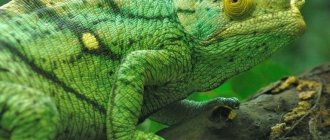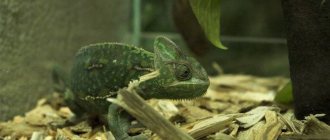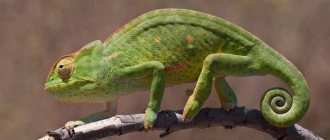Chameleons are interesting representatives of the class of reptiles; their size varies from 3 to 60 centimeters. Tree lizards are excellent climbers of snags and trees, and when they hunt, they can remain motionless for hours. Only the eyes give away the chameleon: they can rotate asynchronously and provide excellent all-round visibility, so tracking down the reptile’s insects is not difficult. The chameleon catches prey using its tongue, and the grasping movement does not take even a second. The insect sticks to the suction cup and quickly ends up in the lizard's mouth.
Can we forget that chameleons can change color? – they owe this property to the unique cells of their skin. Chromatophores (that's what they are called) contain brown, red, yellow and black pigments. Under the influence of certain factors (fear, hunger, hunting), pigmentation intensifies, and the skin acquires various shades.
Often, the behavior of the reptile can be judged by the change in color: the skin turns dark if the chameleon is afraid or tries to instill fear in the enemy, multi-colored spots appear if the male begins to court the female. To absorb heat, chameleons turn almost black, and to reflect light in the heat, they turn light gray.
We want to make a reservation right away: if you hope that while living in your house, the chameleon will delight you with a new color every half hour, you will be disappointed. As a rule, the color of a reptile's skin adapts to its environment: that is, if a chameleon is sitting on a snag, then its color will be brown, and not speckled yellow, as you would like. If the conditions are decent and nothing scares the pet, it is unlikely to change color.
Description of the chameleon
A significant part of the species has a body length within 30 cm, but the largest specimens can easily reach 50-60 cm in size, and the smallest varieties have a body no more than 3-5 cm long. Chameleons are distinguished by fairly long legs, which are peculiarly adapted for climbing . The tail is quite thick at the base, gradually tapering towards the end. Most representatives of the large Chameleon family have a tail that spirals downwards and wraps around tree branches.
This is interesting! The change in color of the chameleon's body is due to the structural features of the skin, as well as the presence of special branched cells called chromatophores.
The animal's eyelids are of a fused type, constantly covering the eyes, but having an opening for the location of the pupil. The movements of the right and left eyes of a scaly mammal can be completely uncoordinated, which is of particular importance in the process of hunting insects. Chameleons are distinguished by their characteristic all-round vision and tongue, the end of which is equipped with a special catching suction cup.
If the mountain doesn't move...
A chameleon looks funny when it decides that its prey will not get close enough to attack: in such cases, it slowly begins to move in the desired direction. With one eye he fixates on the target, with the other he tirelessly examines the surroundings. With a barely noticeable movement, he lifts his front leg, moves it forward slightly, releases it and moves his tail forward, having first moved his hind leg. Moreover, the limbs are able to move like this: first the left, then the right, and not alternately, as we are used to seeing in other quadrupeds. All this is completely silent and looks like slow motion.
By the way, despite the fact that chameleons prefer a sedentary lifestyle, if necessary, they can run quite quickly and even jump from branch to branch.
Buying a chameleon
In nurseries that sell exotics, today you can purchase not only some of the most common types of chameleons from the category of their own breeding, but also natural animals. It is first recommended to make sure that the store or private breeder has an impeccable reputation.
In your hands, the acquired animal should not behave apathetically or too lethargically, and a healthy scaly reptile instinctively defends itself from any “attack”, tries to bite or run away. At the next stage, it is important to conduct a visual inspection of the body to make sure there are no bumps, wounds or swelling on the skin. One of the most significant signs of a chameleon’s health is its color, which determines the state of the exotic.
This is interesting! When a chameleon is kept in poor conditions, the mobility of the scaly reptile is impaired, the appetite is partially or completely lost, the color is too dull or completely uncharacteristic for representatives of the species.
First contact with a person
When you first bring your reptile home, you need to disturb the animal as little as possible to reduce stress and allow the chameleon to adapt to its new location.
To make the chameleon get used to you faster, we recommend hand-feeding it at first. Sometimes you can take your pet out and hold it in your arms.
Gradually, the reptile will get used to you and will even crawl into your arms. There are also especially friendly individuals who spend a lot of time with a person and become strongly attached to him.
If the chameleon is outside the terrarium, you need to make sure that the room is clean and free of other animals and drafts. We do not recommend leaving the reptile outside its special habitat.
Preparing your place of residence
When choosing a habitat for a chameleon, you need to focus on the animal’s lifestyle (arboreal or terrestrial), as well as its age characteristics. In the wild, such a reptile most often prefers wooded areas and trees, less often it lives in not too deep earthen burrows.
Particular attention should be paid to preparing a place for keeping panther and Yemen chameleons, which are quite easy to care for, but are very large in size. In this case, a special house purchased at a pet supply store, or an old aquarium of sufficient volume may well serve as a home.
One of the most important conditions for a full life for a domestic lizard is ensuring air circulation . Stagnant moisture inside the terrarium provokes the development of parasitic bacteria, which have an extremely negative impact on the health and life expectancy of an exotic pet. Humidity levels should be approximately 60-80%.
This is interesting! In addition to simulating grass cover and natural hills made of wood, it is very important to maintain the ideal temperature in the terrarium: during the day at 28-33°C and about 23°C at night.
It is recommended to install a terrarium with scaly reptiles high enough, in the least crowded place, due to the increased susceptibility of chameleons to stress and loss of appetite. A heated area is provided inside the home of the heat-loving reptile. For this purpose, an incandescent lamp is built in, the power of which is approximately 40-60 watts. A good result is achieved by installing a special heated mat.
Interesting Facts
- The Yemen chameleon is one of the most aggressive and largest species in the entire chameleon family.
- It is known that the tongue of this reptile is often 1.5-2 times longer than its entire body. Its structure is such that in the resting position it is located in the mouth, held by the cartilaginous bone of the lower jaw. At the moment of attack on prey, the lingual muscle tenses and, with the help of cartilage, the organ is sharply pushed out, then it relaxes, and the lizard pulls it back into the mouth.
- The Yemen chameleon is the most common species among reptile enthusiasts. Every day, all over the world, a huge number of these animals are sold.
It received its name from the region where the species was originally described—the western coast of Yemen, where it still lives. They also inhabit the Arabian Peninsula on the southwestern coast of Saudi Arabia in the wild. They live on the branches of various types of tropical trees.
The right diet
In their natural habitat, chameleons are predators, feeding on various animals and insects, which the exotic reptile hunts with the help of a long and sticky tongue. The main diet of chameleons consists of non-venomous, flying and crawling insects, including:
- Zhukov;
- spiders;
- flies;
- butterflies;
- dragonflies;
- grasshoppers;
- locusts
Some particularly large scaly reptiles also feed on lizards, rodents and small birds. When kept in apartment conditions, the basis of the diet of an exotic pet should be represented by animal and plant foods. During the day, the reptile is able to eat about 5-10 insects, the number of which directly depends on the appetite and individual needs of the animal.
This is interesting! The reptile practically cannot drink from any container, but is quite capable of consuming liquid through a syringe, pipette or special pump, and chameleons give particular preference to natural juices and non-concentrated honey solutions.
Food of plant origin allows you to replenish moisture in the chameleon’s body and saturate it with essential vitamins. Also forage are the tender leaves of various trees and tree bark, some juicy fruits and berry crops, including kiwi, bananas and persimmons, grapes, cherries, apples and pears, watermelon and melon. Soft vegetables, citrus fruits, herbs and green salad leaves are well eaten by exotics.
Caring for a chameleon at home
Experts recommend installing a UV lamp inside the terrarium for good calcium absorption by animals . Standard care for a reptile at home requires turning on such a lamp for several hours a day. If necessary, it is possible to replace a traditional full-spectrum lamp (with UVA/UVB rays) by organizing sunbathing during a short walk outside
To make it easier to care for the scaly reptile and clean the terrarium, it is recommended to line its bottom with clean and crushed coconut husks. You can also use artificial turf, sand, sphagnum or regular vermiculite as flooring.
This is interesting! It should be remembered that only a female and a male can be kept together in the same terrarium, since a pair of males will almost constantly fight for dividing the territory.
For ventilation, holes are made in the walls of the terrarium, and the upper part must be covered with a plastic grill. General cleaning is performed a couple of times a month.
Arrangement of the terrarium
A properly equipped terrarium will become a home for the chameleon.
If you take a small lizard, then keep in mind that it should not be cramped not only for a small one, but also for an older one. Choose a vertical terrarium with a height of 80 cm or more. If you take a female, then maybe a little smaller. The length and width should be approximately 50 cm. The terrarium should not be completely glass. It is optimal if there are mesh walls and ceiling - this is necessary for good ventilation. Heated air should circulate inside and create a favorable microclimate. Chameleons need warmth, so in winter, do not place the terrarium near cold windows and avoid drafts.
To make your pet comfortable and grow healthy, you will need two lamps - one for heating and one for ultraviolet. Using a heating lamp, the required temperature is maintained at 27-29 degrees. A heating point with a temperature of 32-35 degrees will be created around it, where the lizard will come if it wants to warm up.
Experienced breeders advise turning off the lamps after 13 hours and thereby indicating the onset of night. This is the maximum duration of daylight hours, the minimum is 12 hours. At night in the terrarium it should be +22 +24 degrees.
In addition to heat, it is important to maintain the desired humidity - about 50% and not higher than 80%. To do this, in addition to a thermometer, purchase a hygrometer.
To keep the chameleon's home humid enough, spray the moisture:
- using an automatic spray system;
- spray bottle - including treating plant leaves with warm water.
A bedding made of coconut husks or other similar material will help maintain humidity levels. If it is too humid, adjust the water supply to prevent mold and mildew from appearing. When choosing a rocky substrate, before placing it in the terrarium, it is first washed with warm water and boiled, or calcined with fire.
The flora in the terrarium can be anything. The main thing is that the chameleon has somewhere to climb and hide. These include plants, sticks, and driftwood.
Health, disease and prevention
The most common disease of chameleons is infection with parasites through poor-quality food or poor water, therefore, even if careful sanitation conditions are observed, it is necessary to check the health of the reptile twice a month by taking tests. No less often, scaly reptiles are infected with subcutaneous nematodes, for the removal of which surgical incisions are made.
The second most common disease among chameleons is metabolic bone disease, which occurs when there is an oversaturation or deficiency of calcium, phosphorus or vitamin D3. With this pathology, the limbs become increasingly fragile, bend and break. A characteristic anorexia of the tongue also appears, preventing independent consumption of water and causing the painful death of an exotic pet.
Quite often, chameleons suffer from dehydration, which is accompanied by lethargy and a complete lack of appetite, as well as the sunken eyes of a domestic lizard. To avoid such problems, it is necessary to provide the animal with sufficient drinking conditions by drinking the reptile with clean water from a pipette or sprinkling liquid on the vegetation inside the terrarium.
This is interesting! In order to prevent many diseases, the pet is provided with a complete diet, supplemented with special vitamins and basic mineral supplements.
Also, owners of indoor scaly reptiles often face stress that can arise during the process of transporting a chameleon or exposing the pet to loud or too harsh sounds.
It is very important to install the terrarium in a sparsely populated place, to protect your exotic pet from unnecessary negative emotions, and to handle the reptile as little as possible.
Reproduction at home
Yemeni chameleons reproduce quite easily in home conditions; mating occurs within 24 hours after the female is introduced to the male. A pregnant female acquires a dark green, almost black color with round bright yellow spots. After mating, the aggressive female drives the male away from her, and after about a month oviposition occurs. For this process to be successful, a container filled with moist vermiculite is placed in the terrarium for laying eggs.
The reptile eggs are incubated in a small aquarium with vermiculite, placed at a distance of 10 mm from each other . During this period, it is necessary to maintain the temperature during the daytime at 28-29°C with a drop at night to 20-22°C. Depending on the incubation conditions, small chameleons are born in about 4-9 months. By the age of three months, males are necessarily seated in different terrariums.
Breeding
They become sexually mature at the age of 9-12 months. If you place a suitable partner with them, then it is quite possible to get offspring.
Usually, a planted female causes activity and mating games in the male, but you need to make sure that there is no aggression.
If the female is ready, she will allow the male to court her and mate. They can mate several times until the color changes to dark, indicating that she is pregnant.
The dark color of the female is a signal to the male that he should not touch her. And she becomes very aggressive at this time.
After about a month, the female will begin to look for a place where she will lay eggs. She sinks to the bottom of the terrarium and looks for a place to burrow.
As soon as you notice this, add a container of moist vermiculite or fiber to the terrarium.
The mixture should allow the female to dig a hole without crumbling. Moreover, the container should be large enough, at least 30 by 30 cm. The female can lay up to 85 eggs.
They will incubate at 27-28 degrees for 5 to 10 months. You can transfer the eggs to an incubator, where it will be easier to monitor them and remove unfertilized ones.
Chameleon walking, interaction
Chameleons certainly do not need daily walks, but periodic walks benefit the scaly domestic reptile. It is recommended to walk the reptile in a small fenced area with as clean vegetation as possible and the complete absence of any objects that could injure the pet.
After a walk, the exotic animal must be carefully examined. It is best if the reptile sunbathes not in direct sunlight, in the morning or evening.
Owner reviews
Today, breeding exotics at home is incredibly popular, and keeping highly specialized arboreal reptiles does not pose any particular problems even for beginners. Possessing a curious and quite sociable character, easy-to-care reptiles attract attention with their amazing abilities, which are manifested in a change in color and the ability to close their eyes when “shooting” their tongue. In this case, the color change occurs in 20-30 seconds, and closing the eyes allows the exotic to protect the eyes from injury.
The health of the reptile is extremely negatively affected by temperature changes, as well as drafts and low temperatures . Chameleons have fairly well-developed vision, but their hearing is rather weak, so the animal needs protection from bright light. It should be remembered that only three species of chameleons feel great in captivity and are able to quickly adapt to the microclimate in the terrarium.
This is interesting! A vertical exoterrarium should have an optimal volume of 100-120 liters.
You also need to spend money on a lamp for UV radiation and heating the air inside the home. In their natural habitat, exotics lick water from branches and leaves, so there is no need to install a drinking bowl. Regularly you need to spray the inner surface of the terrarium with a spray bottle. Failure to comply with this rule may cause the death of your pet from dehydration.
To start or not?
Today, the inhabitants of home exoterrariums are a variety of species of lizards: from iguanas to geckos. Some people who like to tickle their own nerves even get huge monitor lizards or snakes. And, of course, the specifics of keeping this pet (temperature conditions, feeding ration, and care nuances) completely depend on who exactly will live in your terrarium. Therefore, it is not enough just to familiarize yourself with the general recommendations for keeping reptiles in the house; you need to study in detail all the available information about exactly the species that you are planning to keep. Indeed, despite their rather repulsive appearance for many people, snakes, iguanas and other creatures in reality are very fragile and vulnerable creatures. This is especially true for chameleons - the strangest and most mysterious inhabitants of planet Earth.
Chameleons are medium-sized insectivorous lizards that most often live on tree branches. The unique ability of these creatures is that they can use camouflage (the color of a chameleon can vary from gray to light green). With such changes in skin tone, it can be extremely difficult to see them in the mass of foliage.
It is this feature that has become a fashionable “trick” of chameleons, which most of all attracts exotic fans to reptiles. This is why chameleons so often become pets to be proud of and show off. However, simply having such a lizard and providing it with the most comfortable living environment is not the same thing. Beautiful creatures by nature have weak immunity and vulnerability to various kinds of diseases - therefore they require especially careful and painstaking care.
Are you ready to create conditions for this creature that ideally replace its usual habitat? Will you be able to take good care of him and devote time to him? These questions are worth thinking about even before you buy a pet.











